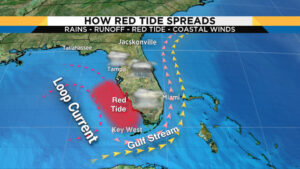
Red tide, also called harmful algal blooms (HABs), is back in Florida waters. With spring break being right around the corner, some may have to cancel or avoid Florida beach plans.
Red tide is an out-of-control growth of algae. It gets its name because it makes ocean water appear a rusty, dark red/brown color.
This uncontrollable growth damages underwater life, causing death to sea animals such as fish, dolphins, manatees, sea turtles and even seabirds.
This is an outrageous spread and happens in Florida when water temperatures are higher than normal and when heavy rain washes nutrients and water pollution into the water.
Spring breakers in Florida usually take advantage of their break and relax at the beach. South Florida is a typical destination for many individuals. Cities like Miami Beach and Ft. Lauderdale are typically flooded with visitors this time of year.
People from all over find themselves walking around South Beach with hopes to mingle with other visitors and enjoy the warm weather. Kennedy Anderson speaks on her spring break plans this year.
“I came from Wisconsin this spring break and I am going to Miami,” said Anderson. “I want to see what the hype is about in Miami Beach, I look forward to getting my spring break tan on and diving into the water.”
However, for several reasons, Anderson does not know that red tide negatively affects Florida waters. Interaction with the tide can result in respiratory issues, skin and eye irritation and possibly death.
Some Florida cities have already reported sightings of Red Tide. Reports include locations from the Tampa Bay area and Marco Island. The Florida Keys in Monroe County have also detected Red Tide signs.
While it may appear that only south Florida is affected, this sort of outbreak negatively impacts the entire state.
Jay Thompson, a third-year student, voiced his concerns about the Florida waters situation.
“I am glad I am aware of this issue because I love the beach, but I will not be going any time soon,” said Thompson. “As a beach person, if I cannot go, I will go to the pool instead.”
Thompson also said he would educate and recommend that people only go to Florida beaches if the water is clear blue.
Jacob Bernard, a former FSU student, witnessed the red tide firsthand.
“As I was fishing, I saw the watercolor change. It was not blue. It was dark brown-reddish,” said Bernard. “Along the shore, I have seen over a hundred dead fish. I was told not to touch the water because I would become sick.”
Florida officials have yet to determine how long the red tide will last in Florida waters. However, it does spread rapidly.
Unfortunately, until official results come out during spring break, Florida waters that contain the red tide must remain closed.